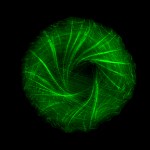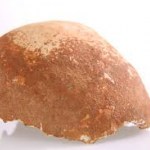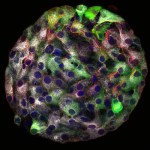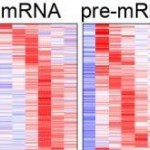Proteins in living cells
Here is today's scientific image:
This delicate, fluffy object is a cytoskeleton viewed under a fluorescence confocal microscope. Below is a time-lape video of the process. For an explanation of why the cell's actin fibers twist around into this shape, go to our website.
[embed]https://www.youtube.com/watch?v=iLm0Ojngjc4[/embed]
Indeed, all three of today's new articles involve crucial cellular dynamics: cutting up unfolded proteins with pared-down molecular "scissors" and binding to metal ions in proteins. In other words, within that lovely shell-like cytoskeleton, the cell is quite a busy…
Manot Cave cranium
With a skull and Keats, there was little choice but to write about the new online items in rhyme. So with apologies to Shakespeare, Keats and the scientists, as well as the people at SpaceIL, here are today's grab bag of poems. As usual, follow the links.
On a Lone Cranium
Alas poor Yorick – We can only know
Where you lived all those eons ago
Walking, did you take those others in stride;
Human, yet strange, as they strode alongside?
Did your children wander forth,
Searching for a greener North?
Can your skull, a bit of bone,
Tell us where our seeds were sown?
To…
What's in a picture?
Prof. Benny Shilo knows the value of a good picture. We recently mentioned his book: Life’s Blueprint, which uses photographs of things like bread dough and yeast cells to illustrate the process of biological development. Here is the image from the most recent piece we have uploaded on his research:
This is an individual Islet of Langerhans, as you’ve never seen it before. The white dots are the insulin-containing vesicles inside the beta cells, which both sense glucose levels and secrete insulin. Shilo and his team managed to get “close-up shots” of the individual cell…
First, there was the great hope of induced pluripotent stem cells (iPSCs), and then there was the inevitable letdown. When the announcement came, in 2006, that simple adult skin cells could be reprogrammed – reverted back to an embryonic stem cell state by the addition of just four genes – it seemed like an almost magical solution to the problems of using stem cells from embryos. But then some studies started to find that the reprogramming process was not perfect – iPSCs were similar, but not identical, to the cells from early embryos. More critically, only about 1% of the cells treated with…
“The public, blog-fueled controversy over the utilization of arsenate instead of phosphate in bacteria was, in the end, a demonstration of what is truly right with scientific quests,” says Prof. Dan Tawfik. “The original findings (that certain bacteria can use arsenate instead of phosphate) may have been overhyped. The research itself may have been underwhelming. But what ensued is exactly what should have happened: The correcting mechanisms that are intrinsic to science kicked in. Other experimental groups examined the claims in their labs and found them to be unsupported. And new scientific…
A somewhat accidental discovery and random meetings between proteins in a cell: These are the subjects of two new online articles. Each, it its way, involves a technological advance that will, in turn, lead to further scientific discovery.
The first involves a partnership between a physics group and a cancer-research group. Among other things, such collaboration is essential for dealing with large data sets - multiple gene expression patterns, for example. When the team made their discovery, they were looking not just at gene expression, but at pieces of genes. More precisely, they were…




